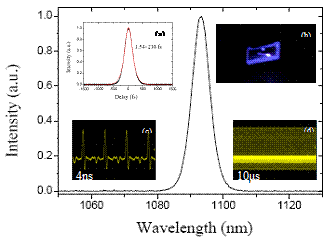New progress of LD pumped solid-state ultrafast laser in Institute of Physics, CAS
As a cutting-edge technology, ultrafast laser has become one of the most active fields in laser research. It is widely recognized that Yb-doped crystals have a significant potential in the development of directly diode-pumped high-power and ultrashort lasers, compared with the traditional ultra-fast laser which is based on Ti:sapphire crystal and equipped in specialized laboratories due to its complexity, high cost and low efficiency. Since 1990s, LD directly pumped Nd3+, Cr3+-doped material picosecond lasers had been demonstrated at 1 micron wavelength, femtosecond lasers also have been realized in Yb-doped materials such as Yb:YAG in last decade. However, the performance of these compact ultrafast laser sources can not parallelized with Ti sapphire laser yet, especially in respect of pulse duration. To date, searching particularly promising materials for high power ultrashort pulse generation remains a fertile subject of laser field. In the last year, Prof. Zhiyi Wei’s group had successfully developed a variety of excellent LD pumped solid-state ultrafast lasers. Collaborated with Shanghai Institute of Ceramics, they generated 210 fs laser pulses at the central wavelength of 1093 nm with the Yb:GYSO laser for the first time. This work not only paved a possible way for using a diode laser at 976 nm wavelength as the pump but also provided a new kind of femtosecond laser at a low cost. Using the laser crystal supplied by Germany scientists, they realized a stable LD pumped mode-locked Nd:GSAG laser operating at quasi-three-level system. The mode-locked pulses were emitted at a repetition rate of 95.6 MHz with pulse duration of 8.7 ps and output power of 510 mW. Collaborated with Shandong University, they demonstrated a femtosecond Yb:YGG laser for the first time. Under the full pump power of 7 W, pulse duration of 245 fs with output power of 570 mW had been obtained at repetition rate of 64.3 MHz. All of these ultrafast lasers perform good stability and beam quality. The figure depicts the spectrum of the mode locking of Yb:GYSO laser, and the inserts are intensity autocorrelation trace, photo of lasing material, pulse trace displayed on oscilloscope with time scale of 4 ns and 10us, respectively. Above works have been published in Optics Letter, Vol. 34, 31 (2009), Optics Letter, Vol. 34, 2324 (2009), Optics Letter, Vol. 34, 3316 (2009) and Applied Optics, Vol. 48, 5978 (2009) respectively, have been selected for “Outstanding Achievements Release Conference of Chinese Optics 2009”.
The authors acknowledge financial supports from NSFC, 2007CB815104 and CAS.



